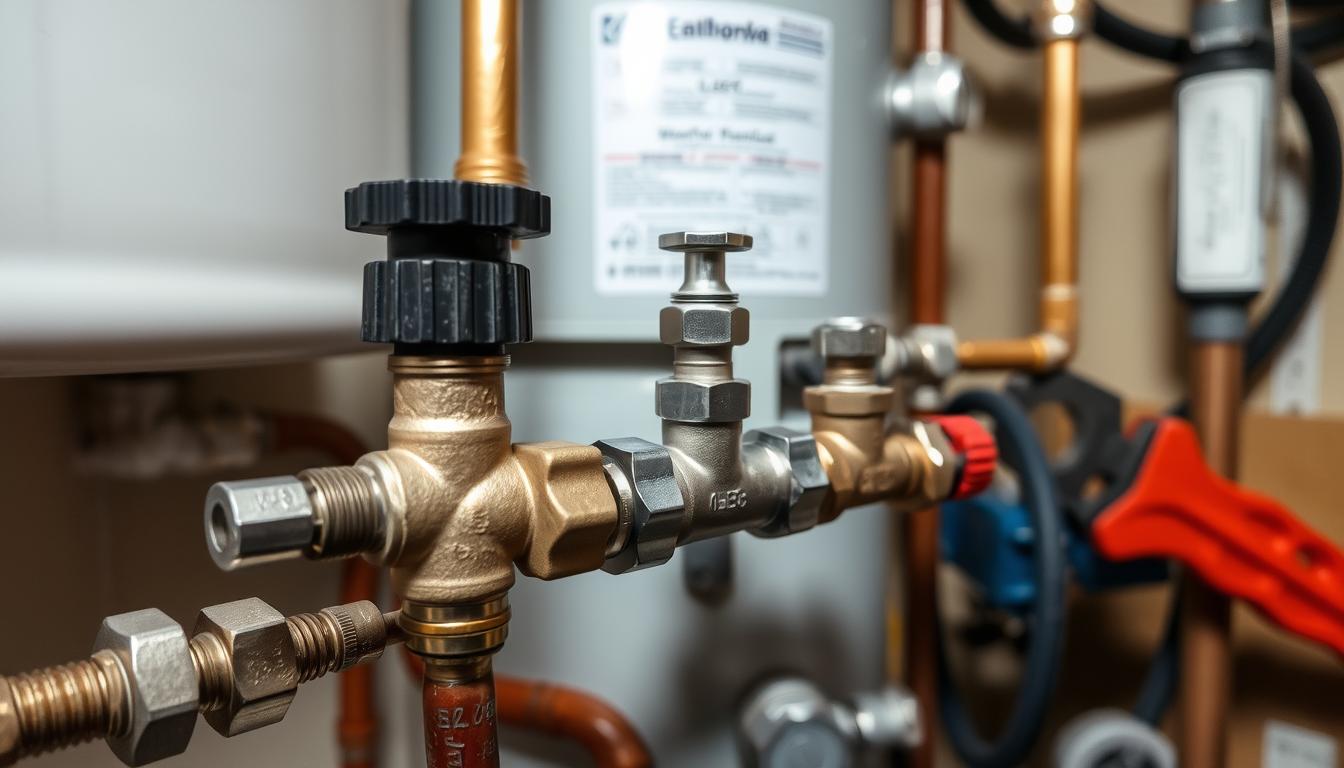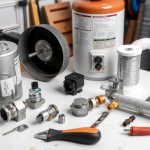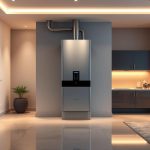When I first stepped into my freezing shower, I knew something was amiss. That moment sparked my interest in understanding water heater valves. These valves are key to keeping our water systems safe and working well.
Water heater valves are often overlooked but play a vital role in our homes. They control water flow, manage pressure, and keep our water safe. Whether it’s a ball valve in newer homes or a pressure relief valve, each one is important for our comfort and safety.
Knowing about these valves can save you time, money, and prevent safety issues. Whether your home is new or old, it’s important to understand your options. This knowledge helps in keeping your water heater in top shape.
Key Takeaways
- Water heater valves are critical for system safety and performance
- Different valve types serve unique functional purposes
- Regular maintenance prevents water heater failures
- Professional installation ensures optimal valve function
- Valve selection depends on home age and specific water system needs
Understanding Water Heater Valves

Water heater valves are key to keeping your home’s water heating system safe and efficient. They manage water flow, temperature, and pressure. These small parts are very important.
What Is a Water Heater Valve?
A water heater safety valve protects your system from damage and high pressure. There are different types of valves, each with its own role in keeping the system working right.
- Regulates water pressure and temperature
- Prevents tank explosions
- Allows for system maintenance
Purpose of Water Heater Valves
The water heater pressure relief valve has many important jobs. Its main task is to let out extra pressure that could harm the tank.
| Valve Type | Primary Function | Safety Impact |
|---|---|---|
| Pressure Relief Valve | Release excess pressure | Prevents tank explosions |
| Shut-off Valve | Control water flow | Enables maintenance |
“A well-maintained water heater valve is your first line of defense against home water system disasters.” – Professional Plumbing Expert
Today’s water heater valves are made with care for the best performance. The Full Port Lead-Free Drain Valve is a big step forward. It has openings up to 8 times bigger than old valves, making it easier to get rid of sediment during maintenance.
Knowing about these valves helps homeowners keep their water heating systems in top shape. This prevents problems and makes the equipment last longer.
Types of Water Heater Valves

Water heater systems use special valves for safe and efficient work. Knowing about these valves helps homeowners keep their systems running well and avoid problems.
Pressure Relief Valves
Pressure relief valves are a key safety feature. They stop dangerous pressure from building up. If pressure gets too high, these valves release steam and hot water, keeping the tank safe from explosions.
Shut-off Valves
Shut-off valves control water flow to the heater. They are vital for maintenance or emergencies. Homeowners can stop water flow quickly, preventing damage or making repairs safe.
- Ball valves: Most reliable and easy to operate
- Gate valves: Traditional design with full pipe opening
- Quarter-turn valves: Quick and efficient water control
Mixing Valves
Mixing valves mix hot and cold water for safe temperatures. They prevent scalding and keep water comfortable at home.
Check Valves
Check valves, like the drain valve, stop backflow. They keep the system safe by making sure water flows only one way.
| Valve Type | Primary Function | Material |
|---|---|---|
| Pressure Relief | Safety pressure release | Brass |
| Shut-off | Water supply control | Brass/Stainless Steel |
| Mixing | Temperature regulation | Brass |
| Check | Prevent backflow | Stainless Steel |
“Understanding your water heater valves is key to maintaining a safe and efficient home water system.” – Plumbing Expert
Features of Solenoid Valves

Solenoid valves are a big step forward in water heater technology. They bring advanced control to plumbing systems. These electric devices change how we handle water flow and safety in our homes.
Solenoid valves stand out in water heater safety. They are different from old mechanical valves. These new valves offer precise control with electromagnetic power.
Functionality of Solenoid Valves
Solenoid valves work with a smart electromagnetic design. This design lets them respond quickly and control water flow well. They open or close fast with just an electrical signal.
- Rapid response time (less than one second)
- Precise flow control mechanism
- Automated electrical activation
- Compatible with smart home systems
Advantages of Using Solenoid Valves
Using solenoid valves in water heating systems has many benefits. They perform well in many situations.
| Feature | Specification |
|---|---|
| Port Size | 3/4″ Female NPT |
| Voltage | 110V AC |
| Pressure Range | Water: 0-145 PSI | Air: 7-145 PSI |
| Flow Rate | Cv 7.6 (Approximately 58 GPM @ 60 PSI) |
| Response Time | Fast Acting (Less than one second) |
Solenoid valves come in two main types: normally open and normally closed. This lets homeowners pick the right valve for their needs.
“Solenoid valves represent the pinnacle of automated flow control in modern water heating technologies.” – Plumbing Engineering Journal
Adding these advanced valves to your system makes it more reliable and efficient. It also protects against water damage.
How to Choose the Right Valve
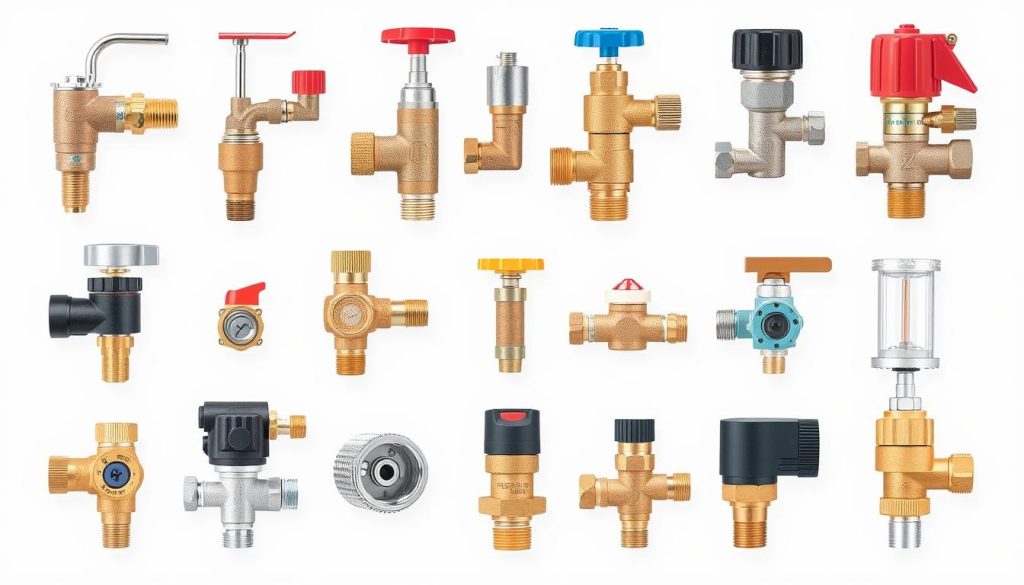
Choosing the right water heater replacement valve is important. It ensures your water heating system works well and safely.
- Pressure rating compatibility
- System requirements
- Material durability
- Temperature tolerance
Critical Selection Factors
There are different types of water heater valves, each with its own role. Ball valves are common in homes because they last long and control water flow easily. The International Residential Code says water heaters need full-open valves.
“Proper valve selection is key to plumbing system efficiency and operation” – Plumbing Experts
Recommended Valve Specifications
Most valves are made for 150 PSI and 210 degrees Fahrenheit. When picking a valve, check these important specs:
- Maximum Allowable Working Pressure (MAWP)
- Temperature rating
- Relieving capacity
- Compliance with ASME/NB standards
Trusted Valve Brands
Brands like Watts, Rheem, and A.O. Smith make top-notch valves. Always check local plumbing codes and what the maker suggests for the best choice.
Tools Needed for Installation

Installing a water heater valve needs careful preparation and the right tools. Both professional plumbers and skilled DIY folks know the importance of having the right tools and safety gear. This is before starting any water heater maintenance valve project.
Choosing the right tools is key to a successful water heater valve installation. The right tools ensure precision, safety, and efficiency during the process.
Essential Installation Tools
- Adjustable pipe wrench
- Tubing cutter
- Propane torch
- Teflon tape
- Level
- Measuring tape
- Wire cutter
- Socket wrench set
Critical Safety Equipment
Safety is always the first thing to think about when working with water heater valves. It’s important to protect yourself from possible dangers during installation and maintenance.
- Heat-resistant work gloves
- Safety glasses
- Fire extinguisher
- Gas leak detector
- Respiratory protection
“Preparation and safety are the foundations of successful water heater valve installation.” – Professional Plumbing Association
When picking tools for water heater valve installation, think about what your water heating system needs. Electric and gas water heaters may need different tool sets. Always check the manufacturer’s guidelines and local plumbing codes before starting your project.
Modern water heaters made after 2015 often have special installation needs. Make sure you have a complete toolkit that meets current energy code standards. It should also handle any design changes in water heaters.
Step-by-Step Installation Guide

Installing a water heater valve needs careful planning and precision. Experts with over 70 years of experience suggest a systematic approach. This ensures safety and effectiveness.
Preparing for Installation
Before starting, gather all necessary tools and take important safety steps:
- Turn off electricity and gas supply completely
- Wear protective safety gear
- Ensure proper ventilation in the work area
- Keep a fire extinguisher nearby
Installing the Water Heater Valve
The installation process requires technical skill and attention to detail. Follow these steps:
- Drain the water heater tank completely
- Disconnect existing water and gas connections
- Clean pipe threads using a wire brush
- Apply Teflon tape to ensure tight sealing
- Position the new water heater valve carefully
- Use appropriate tools like pipe cutter and wrench
“Precision is key when installing a water heater valve. One small mistake can compromise your entire system.” – Professional Plumbing Expert
Testing for Leaks
After installing, it’s vital to test for leaks:
| Test Step | Action | Expected Result |
|---|---|---|
| Pressure Check | Slowly restore water supply | No visible leaks |
| Connection Inspection | Examine all valve connections | Tight, secure fittings |
| Functionality Test | Simulate possible leak scenario | Valve responds correctly |
Pro tip: If you’re uncomfortable with any installation steps, hiring a professional plumber is always recommended to guarantee proper water heater valve replacement.
Common Mistakes to Avoid

Installing a water heater valve needs precision and attention to detail. Homeowners often make mistakes that can be dangerous. It’s important to know these mistakes to keep your water heater working well.
Overlooking Safety Precautions
Safety is the most important thing when working with water heater valves. About 80% of homeowners make mistakes that can be dangerous. Here are some safety tips:
- Always turn off power and gas supply before starting any work
- Wear protective equipment like safety glasses and gloves
- Ensure proper ventilation when working with gas water heaters
- Avoid working alone on complex water heater repair valve replacements
Incorrect Valve Type Selection
Choosing the wrong water heater safety valve can cause big problems. The wrong connections and pressure ratings can harm your plumbing system.
| Common Valve Selection Errors | Potential Consequences |
|---|---|
| Mismatched pipe connections | Accelerated corrosion and possible leaks |
| Incorrect pressure rating | Risk of tank explosion or system failure |
| Wrong valve size | Reduced system efficiency and performance |
“Precision in valve selection is not just about functionality, but about protecting your home and family.” – Professional Plumbing Expert
To avoid these mistakes, consider getting help from a professional plumber. Or, carefully check the manufacturer’s specifications before trying to install or repair a water heater valve.
Maintenance Tips for Water Heater Valves
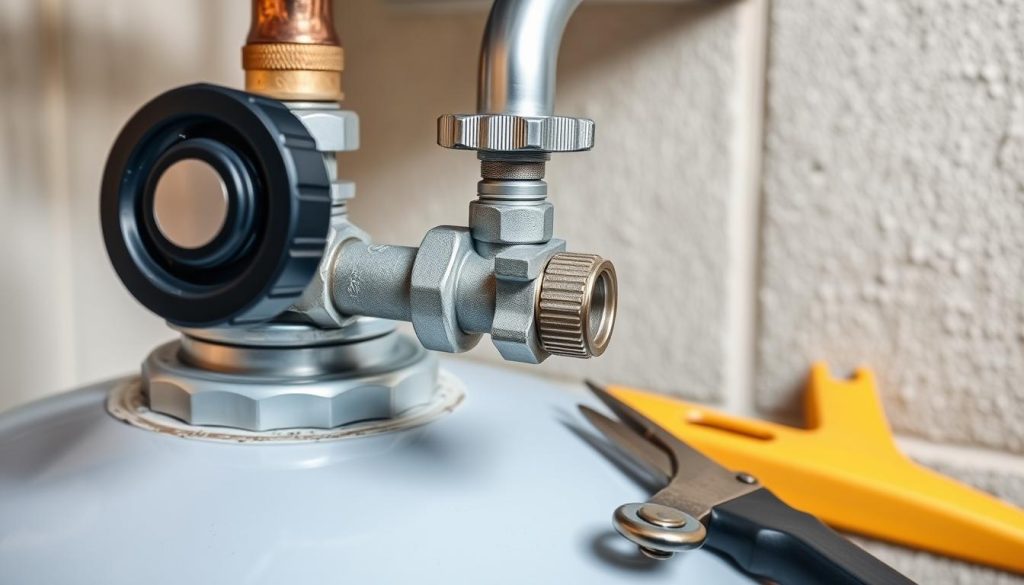
Keeping your water heater valve in good shape is key to its long life and avoiding sudden failures. Taking care of it properly can make your hot water tank last longer and work better.
There are a few important steps to keep your water heater valves working well:
- Do visual checks every two to three months
- Look for corrosion or wear signs
- Test the pressure relief valves once a year
- Clean the valve exteriors to stop mineral buildup
Regular Inspection Techniques
Checking your water heater valve regularly is vital to catch problems early. Homeowners should watch for:
- Signs of rust or corrosion
- Strange noises when the water heater is on
- Leaks around the valve connections
- Lower water pressure
“Preventive maintenance is the key to avoiding costly water heater repairs and unexpected replacements.” – HVAC Maintenance Experts
Cleaning and Care Guidelines
Looking after your hot water tank valve needs some careful steps. Here are some tips from the pros:
| Maintenance Task | Frequency | Purpose |
|---|---|---|
| Visual Inspection | Every 2-3 months | Detect early signs of wear |
| Professional Inspection | Every 4-5 years | Comprehensive system check |
| Valve Cleaning | Annually | Remove mineral deposits |
Pro tip: Always use gentle, non-corrosive cleaning solutions when maintaining your water heater valves to prevent damage to sensitive components.
Experts say to get your water heater valves checked every year. By doing this, you can avoid sudden problems and make your water heating system last longer.
Troubleshooting Valve Issues

Water heater valves are key to keeping your hot water system safe and working well. Knowing common problems and when to get help can save you money and prevent damage.
Identifying Common Water Heater Valve Problems
Many homeowners face issues with their water heater valves. These problems need attention:
- Persistent leaks around valve connections
- Sticking or difficult-to-operate valves
- Unexpected pressure fluctuations
- Corrosion or mineral buildup
Diagnostic Strategies for Water Heater Valve Issues
Here are steps to troubleshoot water heater valve problems:
- Inspect valve connections for leaks
- Test if the valve operates smoothly
- Check system pressure with a gauge
- Make sure the temperature settings are correct
| Valve Issue | Potential Cause | Recommended Action |
|---|---|---|
| Continuous Leaking | Worn seal or loose connection | Tighten connections or replace valve |
| Pressure Discharge | Excessive system pressure | Install pressure regulator |
| Valve Stiffness | Mineral accumulation | Gentle operation or professional cleaning |
When to Call a Professional
Some valve problems can be fixed by yourself, but others need a pro:
- Persistent leaks after trying to fix them
- Complex valve mechanism failures
- Significant pressure regulation problems
- Potential safety hazards
“Regular inspection and timely maintenance can prevent 50% of water heater valve malfunctions.” – Plumbing Industry Experts
About 10% of water heater problems come from faulty valves. Replacing a valve can cost between $100 to $500, depending on the type and complexity.
Pro Tip: Check your water heater valves every six months to avoid costly repairs and keep your system running smoothly.
Understanding Valve Regulations
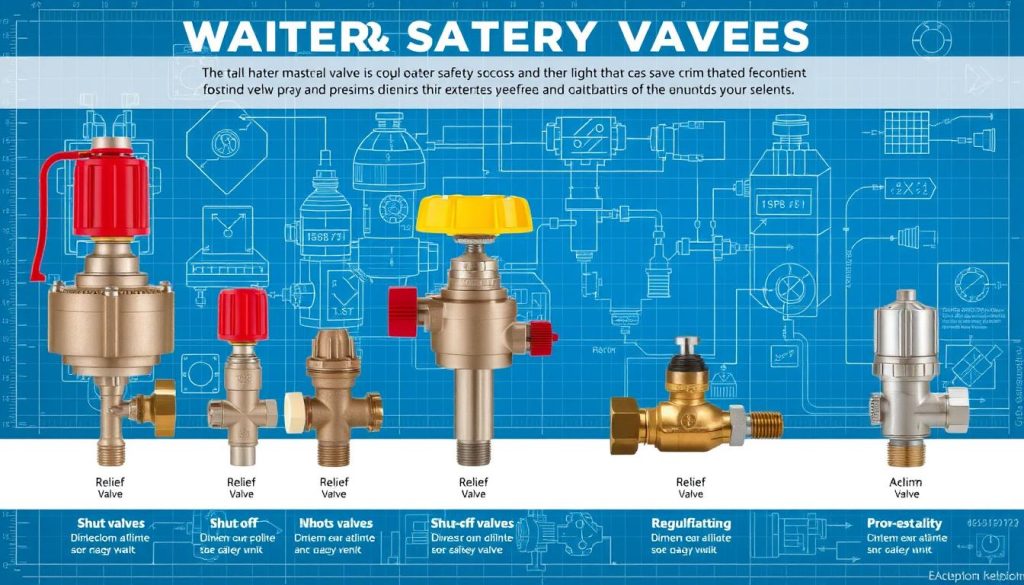
Water heater valve regulations can be complex. It’s important to know both national and local standards. Safety is key when installing a water heater safety valve. Knowing the rules helps homeowners and professionals do it right.
National Plumbing Code Requirements
The National Plumbing Code sets important rules for water heater valve installations. These rules cover many aspects of valve safety and performance:
- Discharge piping material specifications
- Installation height and positioning
- Pressure and temperature ratings
- Compliance standards for valve construction
“Proper valve installation is not just a recommendation—it’s a critical safety requirement.”
Material and Technical Specifications
| Valve Discharge Piping Materials | Compliance Details |
|---|---|
| CPVC Plastic Pipe | Approved for relief valve discharge |
| Copper Pipe | Meets 100 PSI pressure rating |
| Stainless Steel Pipe | Recommended for durability |
| PEX Tubing | Compliant with ASME standards |
State-Specific Regulations
While national standards are a starting point, states may have their own rules. Homeowners and professionals need to:
- Check local building codes
- Verify specific valve rating requirements
- Obtain necessary permits
- Schedule professional inspections
Following both national and local rules ensures safety. It also prevents insurance issues and protects against hazards from wrong valve installations.
The Importance of Timely Replacement

Water heater valves are key to keeping your home’s hot water safe and efficient. Knowing when to replace them can avoid big problems and save money.
Signs of a Failing Valve
Spotting a bad water heater repair valve is vital to avoid system failures. Look out for these signs:
- Visible corrosion or rust on the valve
- Persistent water leaks around the valve connection
- Difficulty in valve operation
- Unusual noises during water heating
- Inconsistent water temperature
Benefits of Early Replacement
Replacing water heater valves early has many benefits for homeowners. It stops costly water damage and keeps your system running well.
| Replacement Benefit | Potential Impact |
|---|---|
| Prevent Water Damage | Avoid costly repairs to floors, walls, and appliances |
| Maintain System Efficiency | Reduce energy consumption by up to 18% |
| Ensure Safety | Prevent possible gas or electrical hazards |
“Regular maintenance and timely valve replacement can save homeowners significant money and prevent possible safety risks.” – Home Maintenance Expert
Most water heaters last 10-15 years. Regular checks of the valve can spot issues early, before they get worse.
Getting a water heater repair valve replaced on time protects your home. It also keeps your hot water flowing and your system working right.
Comparing Costs for Water Heater Valves
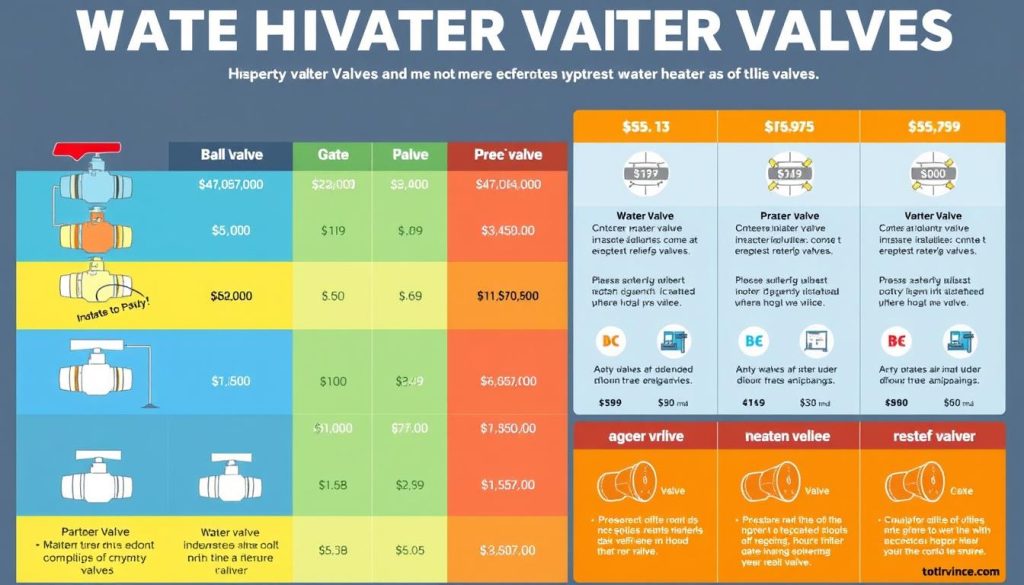
Understanding water heater valves can be tricky, mainly when looking at the cost. Prices range from simple shut-off valves to complex pressure relief systems. Homeowners need to balance their budget with quality and safety for their water heaters.
When thinking about replacing a water heater valve, knowing the price range is key. The costs vary a lot, based on the valve type and how it’s installed.
Budgeting for Different Valve Types
Water heater valves have different prices, showing their quality and function. Here’s a cost overview:
- Basic shut-off valves: $10 – $30
- Pressure relief valves: $20 – $100
- Mixing valves: $50 – $200
- Gas control valves: $100 – $300
Cost of Installation: Professional vs. DIY
Homeowners must choose between hiring a pro or doing it themselves for valve replacement. Professional services cost $100 to $300, based on local rates and complexity.
| Installation Type | Estimated Cost | Pros |
|---|---|---|
| Professional Installation | $100 – $300 | Guaranteed work, warranty, expert precision |
| DIY Installation | $10 – $250 | Cost savings, personal satisfaction |
Pro tip: DIY can save money, but wrong installation risks safety and more costs. Always consider the long-term benefits over short-term savings.
Investing in a quality water heater replacement valve is not an expense, but a vital home maintenance strategy.
Environmental Considerations

Modern water heater valve technologies are changing how we think about energy and water. The right valve can cut down on environmental harm and boost system performance.
Energy Efficiency Strategies
New water heater valves come with energy-saving features. Thermostatic mixing valves let water heaters run at the best temperature while keeping water safe. Key energy-saving steps include:
- Using smart valve technologies
- Choosing valves with precise temperature control
- Integrating home automation systems
Water Conservation Techniques
Choosing the right water heater valve is key for saving water. New valve designs cut down on waste and boost system efficiency. Good conservation tips include:
- Installing low-flow water heater valves
- Using recirculation systems with strategic valve placement
- Choosing valves made from eco-friendly materials
*”Efficient water heater valves are not just about performance—they’re about responsible resource management.”*
By picking water heater maintenance valves that focus on energy efficiency, homeowners can lessen their environmental impact. They can also keep their water heating at its best.
Practical Efficiency Insights
Here are some efficiency tips for choosing water heater valves:
- Recommended water temperature: 120°F (49°C)
- Temperature above 140°F helps control bacterial growth
- Annual maintenance can improve valve and system efficiency
Final Thoughts on Water Heater Valves
Water heater valves are key to keeping homes safe and efficient. Knowing how each valve works can stop big problems and save money. These small parts protect our water heaters from leaks, pressure, and sudden failures.
New tech is changing water heater valves for the better. Now, we can monitor and control them like never before. Thanks to smart home tech, we can catch leaks and stop systems fast. Companies like Bradford White are adding even more safety features to their valves.
Summary of Key Points
Managing water heater valves is important. You should get them checked by pros, know how to install them right, and watch out for safety issues. Manufactured homes need special care because of their unique setup. Keeping up with maintenance can prevent big problems like Legionella growth and system failures.
Future Developments in Valve Technology
The future of water heater valves is exciting. New tech will make them safer, more energy-efficient, and easier to monitor. Advances in materials and sensors will help valves predict and prevent problems. This means homeowners will have more peace of mind and reliable systems.
